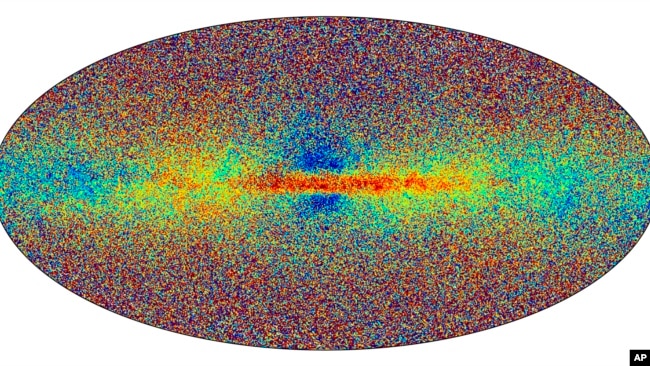ESA、天の川銀河20億個のデータ公開
まずは、こちらをご覧ください⬇️
Gaia data release 3: exploring our multi-dimensional Milky Way
2022/06/13
我らが属するミルキーウェイ!! ニュージーランドの星空が懐かしい!!
VOAで英語を学びましょう!!
欧州宇宙機関、20億個の星のデータを公開(和訳)
European Space Agency Releases Data on 2Billion Stars
June 19,2022
2022年6月13日(月)、欧州宇宙機関が提供した全天画像は、ガイアのデータリリース3に含まれる天の川の星のサンプルです。色は星の金属量を示している。赤い星ほど金属に富んでいる。(ESA Handout via AP)
欧州宇宙機関、ESA、はこのほど、天の川銀河にある約20億個の星についての詳細な情報を発表しました。
このデータは、銀河系の最も完全な地図を作成するために収集されたものです。
このデータは、ESAの宇宙観測所Gaia ガイアから収集されたものです。
天文学者は、このデータを使って、星がどのように生まれ、どのように死んでいくのか、そして天の川が何十億年もかけてどのように変化してきたのかをより理解したいと考えています。
このデータには、星の年齢、大きさ、温度、化学的性質などの新しい情報が含まれています。これらの情報は、例えば、どの星が別の銀河系で生まれ、天の川銀河に移動してきたかを調べるのに利用できます。
「これは天文学にとって信じられないような金鉱です。」と、アントネラ・バレナーリ氏は言います。彼女は450人の科学者とエンジニアのグループを率いるのに貢献しました。彼らは何年もかけて、宇宙観測所が収集した測定値を利用可能な情報に変換しました。
ガイアはまた、10万回以上の星震を発見することができました。ESAは星震を、星をまたぐ大きな津波に例えます。それらは、星の明るさを短時間で変化させるようです。宇宙物理学者のコニー・アーツ氏は、この地震によって星の密度、内部回転、内部温度などを測定することができると言います。
科学者たちは、天の川の星の約1パーセントについてしか情報を収集していません。しかし、ガイア・ミッションはすでに年間約1,600件の科学論文に十分な情報を提供しています。
プロジェクト・サイエンティストのティモ・プルスティ氏は、観測された星の数が多いほど、科学者が発見をする可能性が高くなると話します。
「干し草の山の中の針を見つけるためには、たくさんの天体を観測しなければなりません。」と、彼は言います。
ヨゼフ・アシュバッハー氏はESAの代表です。彼は、この新しいデータは天文学者が銀河系内の力を理解することを可能にすると述べています。例えば、我々の太陽系が天の川銀河の中でどのように動いているのかを示すことができるのです。
「この大量のデータがなければ決して実現できなかったことを可能にしています。」と彼は言います。
現在公開されているガイアのデータには、他の星の周りを回る星である連星80万個の情報も含まれています。また、太陽系外の新しい惑星数個、太陽系内の小惑星数十万個、銀河系外の天体数百万個に関するデータもあります。
European Space Agency Releases Data on 2 Billion Stars
The European Space Agency, or ESA, recently released detailed information on almost 2 billion stars in the Milky Way galaxy.
The data is being collected in an effort to create the most complete map yet of our galaxy.
The data was gathered from ESA’s Gaia space observatory.
Astronomers hope to use the data to better understand how stars are born and die, and how the Milky Way has changed over billions of years.
The data includes new information like the age, size, temperature and chemical properties of stars. This information can be used, for example, to find out which stars were born in another galaxy and then moved to the Milky Way.
“This is an incredible gold mine for astronomy,” said Antonella Vallenari. She helped lead a group of 450 scientists and engineers. They spent years turning the measurements collected by the space observatory into information that can be used.
Gaia was also able to find more than 100,000 starquakes. ESA compared starquakes to large tsunamis that go across stars. They appear to make the stars’ brightness change for a very short period of time. The events let scientists measure the stars’ density, interior rotation and inside temperature, said astrophysicist Conny Aerts.
The scientists have only collected information on about one percent of the Milky Way’s stars. But the Gaia mission is already providing enough information for about 1,600 scientific publications a year.
Project scientist Timo Prusti said the large number of stars observed makes it more likely that scientists will make discoveries.
“You have to observe a lot of objects in order to get the needle in the haystack,” he said.
Josef Aschbacher is head of ESA. He said the new data permits astronomers to understand forces in the galaxy. For example, it could show how our own solar system is moving inside the Milky Way.
“It is enabling things that would never be possible without this large number of data,” he said.
The Gaia data now being released also includes information on 800,000 binary stars, which are stars in orbit around another star. There is also data on several new planets outside the Solar System, hundreds of thousands of asteroids in the Solar System and millions of objects beyond our galaxy.
Words in This Story
gold mine — n. something that produces a lot of something that is valuable
tsunami — n. a huge ocean wave caused by an undersea earthquake
rotation — n. the motion of turning around a central point
needle in the haystack — expression one important thing hidden in a lot of unimportant material
enable — v. to make something possible or able to be don
